Audio file formats are at the atomic level of music production.
When you create audio to send out to a streaming platform or burn to a CD, you have to store it somehow.
Of course, with so many audio file format types, it can be difficult to know which one you need to use for your particular situation.
The question becomes,
Which audio file format do you need to use to make sure your sound quality is the best it can possibly be?
In this short guide, we're going to discuss all you need to know about audio format types so you can pick the correct one for the job at hand.
Let's dive in!
What Are Audio File Formats?
You can think of an audio file format as storage space for audio information.
When raw audio data moves out of your audio interface through the analog-to-digital converter, your interface will use pulse code modulation (PCM) to encode it.
To play that pulse code modulation back using a physical system, you must organize the information into a playable file.
You can differentiate audio file format types by the containers they're found in and the data compression methods they use to keep the PCM streams in order.
Now, while these various formats represent the same information, the quality levels and storage space are different.
Some audio formats even have unique characteristics, such as metadata storage, which supplies content or file information.
A Deeper Dive Into PCM
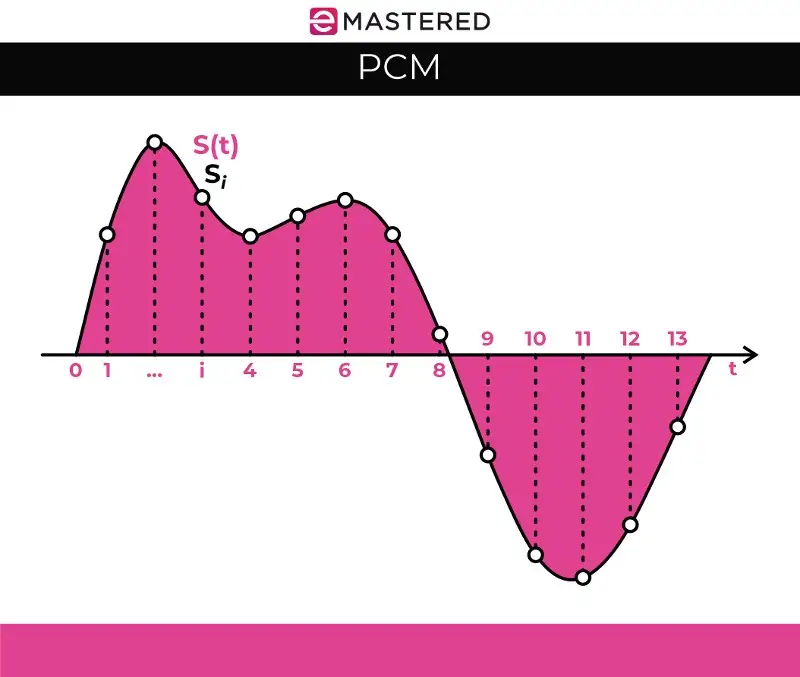
As we said before, PCM, or pulse-code modulation, is the method in which we convert analog signals into signals that can be used in the digital domain. This conversion process encodes waveforms with bit depth and sampling rate. The bit depth is the number of bits per sample, while the sampling rate is the number of samples per second.
The majority of digital formats have a sampling rate of 24-bit/44.1kHz.
The 3 Main Groups of Audio Formats
The easiest way to think of audio formats and how they differ from one another is by dividing them into three main groups:
- Uncompressed audio format
- Lossy Compressed Audio Format
- Lossless Compressed Audio Format
Check out the table below, which connects each of the main audio formats with its encoding type:
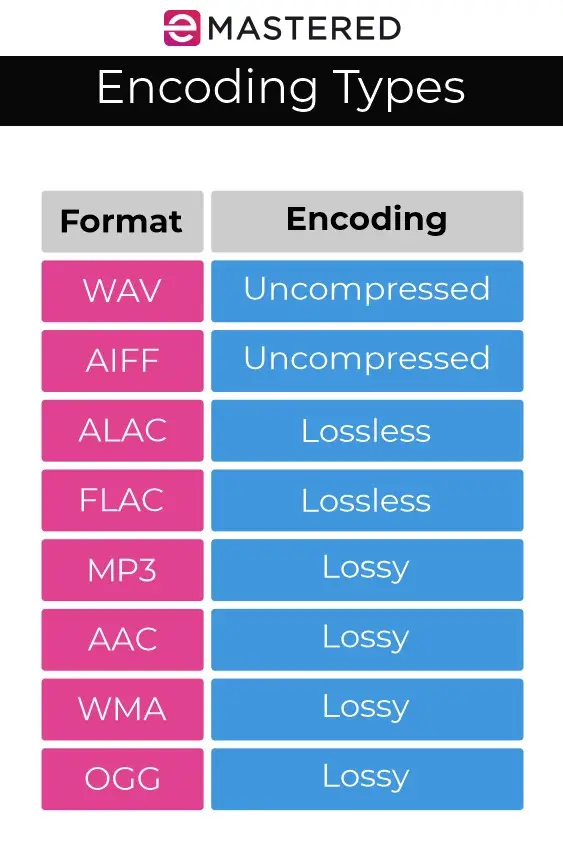
Lossy Audio Files Vs. Lossless Audio Files
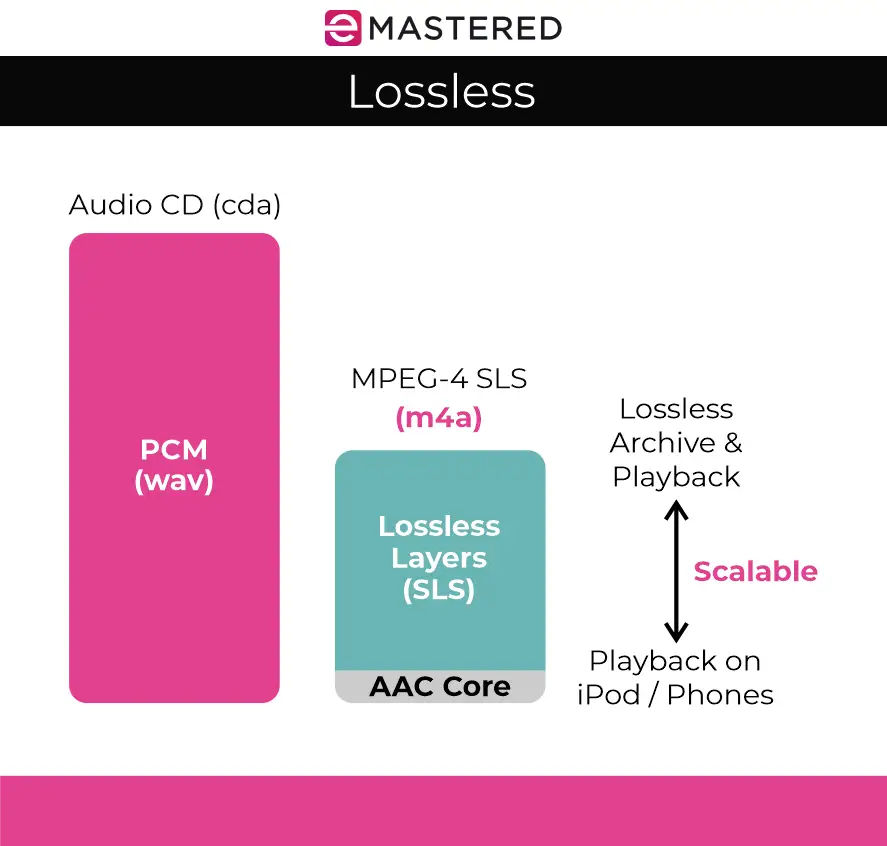
In the wide world of audio files, you'll find lossy and lossless file formats, which differ in terms of data compression .
We use data compression as a practical tool to fit more files on a hard drive. You can think of it as zipping a number of single files on your computer to get a smaller file to store. This type of compression is very different from compressed audio in mixing or music production.
Contrary to what many believe, there are data compression methods that can make files smaller while preserving the full integrity of the information found in the audio stream. We refer to these audio formats as lossless compressed formats .
On the other hand, you have lossy compressed formats , which eliminate data within the audio stream without majorly impacting the sound. However, there is information that is tossed out using this kind of compression method.
Compressed Audio Formats vs. Uncompressed Audio Formats
Audio formats without any form of compression are known as uncompressed audio formats .
These are containers that store raw audio data without any sort of quality or size reduction. While these files might be much larger than compressed audio files, they will deliver the most detail and audio fidelity.
You will often find these types of files used for various steps in music production, such as recording or mixing.
Even so, not all uncompressed audio files are the same. You'll find varying levels of quality in these files based on the way in which the analog signal was digitally converted. Different types of analog-to-digital converters use different levels of precision and accuracy.
When you use a higher bit depth and sample rate during the conversion process, you can capture more information.
Bit depth is the number of bits of information in an audio sample, which directly refers to each sample's resolution. For example, a CD uses 16 bits per sample, while the audio on a DVD uses 24 bits per sample.
The preciseness in which an analog-to-digital converter can measure amplitude or signal volume is where we get bit depth.
I often like to think of bit depth, like the small marks on a measuring tape. Lower bit depth can be the inch markings, which are much further apart, while higher bit depth can be the centimeter markings. Essentially, higher bit depth takes into account a greater number of smaller, individual measurements.
Understanding Bit Rate
Bitrate is the amount of data produced by a file every second.
When you listen to digital audio, you'll see files that have a "kbps" marking at the end to tell you the bitrate that is associated with it.
Every second of an audio recording contains a set amount of bits. We calculate these bits by "data per second." For example, if you see an audio file that has "280 kbps" on it, that means that there are 280 kilobits in each second of audio on that stream.
We use bitrate, which is the amount of data encoded each second, to determine the quality of a file format.
While you get smaller compressed files with lower bitrate settings, the audio quality isn't as high. When hard drives first came about, it was necessary to have low-bit-rate audio, as we didn't have the type of storage capacity we have now. This was the same for most computers, which didn't have the bandwidth to transmit larger files.
In the modern digital world, bandwidth and storage aren't issues we need to worry about, which is why it's always recommended you use the highest bit rate possible when working with lossy formats.
For example, if you're working with an MP3, the standard for high-quality is 320 kbps. With these high-end settings, it can be rather hard to differentiate compressed audio and uncompressed audio when listening casually.
Understanding High-Resolution Audio
Now, you might be wondering,
What about high-resolution audio?
High-resolution audio is quite unique in that there is no single standard for it.
However, when producers and engineers talk about high-resolution audio, they're often referring to audio files with sampling frequencies or bit depth above the CD standard, which is 16-bit/44.1kHz.
In our eyes, high-resolution files are 24-bit/48kHz, 24-bit/96kHz, and 24-bit/192kHz.
The beauty of hi-res audio files is that they contain far more information than low-res files or compressed audio, meaning the sound quality is much better. While hi-res audio takes up more storage space, it can be worth it if the quality is what you're after.
Some of the most popular uncompressed high-resolution audio files include WAV and AIFF, though there are also FLAC and ALAC audio formats as well.
Common Audio File Formats
While there are several different audio file formats out there, not all of them are super common.
In your general music production journey, you'll likely only ever come across a few different audio format types. Here are some of the main ones you should know:
MP3
The most common audio format for casual listening is MP3.
When the early 2000s rolled around, Mp3s rose the ranks in popularity, all thanks to the file-sharing revolution that Napster started. In October of 2001, Steve Jobs pulled a small device out of his pocket with 1,000 of these files on it.
What was so great about MP3s was how much information we were able to store in such small containers while retaining sound quality.
Of course, one of the reasons MP3s were at the center of illegal music downloading was due to the fact that they were easy to encode from CDs.
In today's world, MP3s are still one of the most common audio file format types. Even major digital audio download stores like Bandcamp still use MP3s as their main format.
They are some of the most convenient files for storing music on tablets or portable playing devices. Plus, MP3s work on just about every playback device.
The bit rate at which MP3s are recorded can greatly impact the quality of their sound. For example, an MP3 with 128kbps encoding will have lesser sound quality than an MP3 with 320kbps encoding.
Look below to get an idea of the size of MP3 files vs. other file types:
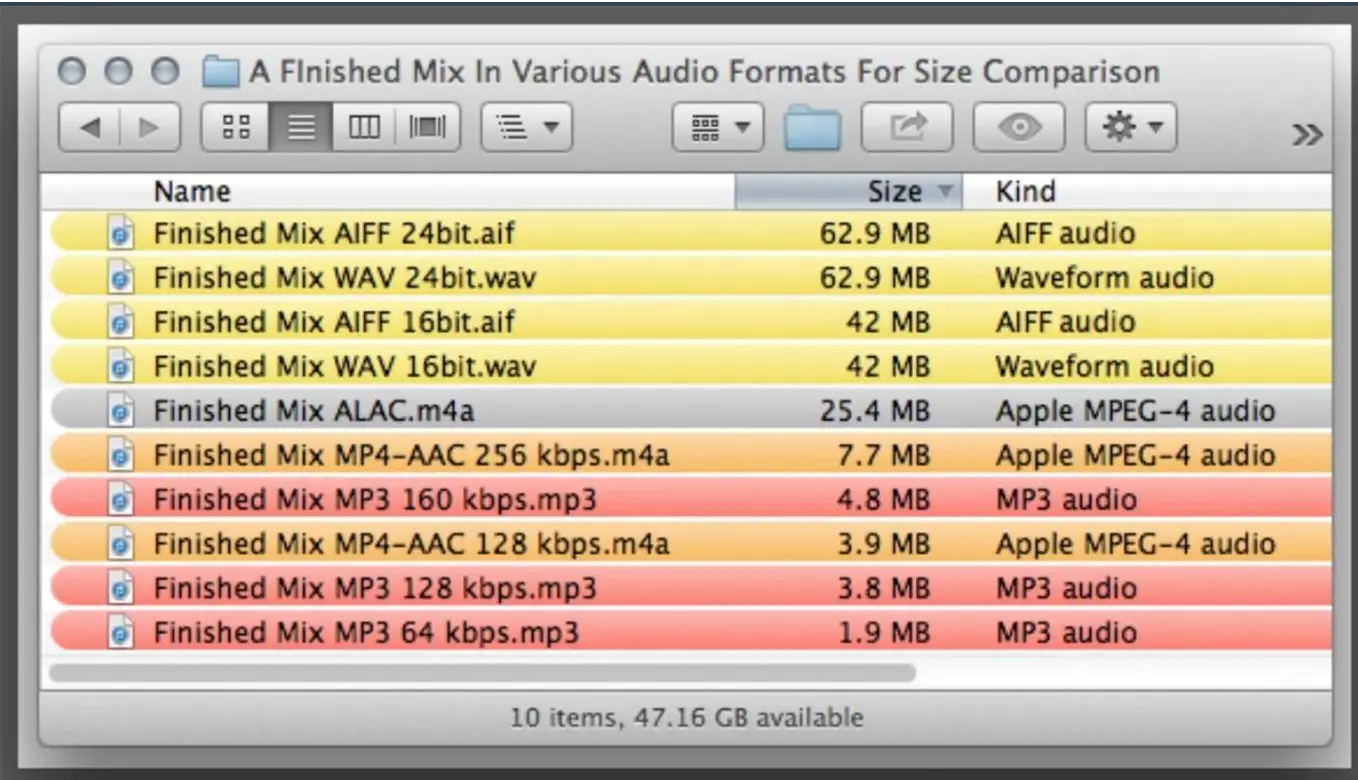
FLAC/ALAC/WMA
FLAC files are open-source lossless compressed audio files. This audio file format was one of the very first lossless formats to be put to popular use. FLAC stands for Free Lossless Audio Codec. These files are about half the size of your standard WAV or AIFF file with an equal sample rate.
However, you don't get any loss in audio quality with FLAC files. They are better than CD-quality, as they provide up to 32-bit/96kHz resolution.
The beauty of FLAC files is that they allow users with limited storage on their listening devices to enjoy lossless audio. While it can be hard for the average listener to tell the difference between FLAC and MP3, many audiophiles are quick to debate the differences.
ALAC is very similar to FLAC, though it was developed by Apple. This file type stands for Apple Lossless Audio Codec.
ALAC is a great alternative to FLAC for Apple Music or iOS users. Do note that ALAC files are slightly larger than FLAC files, though.
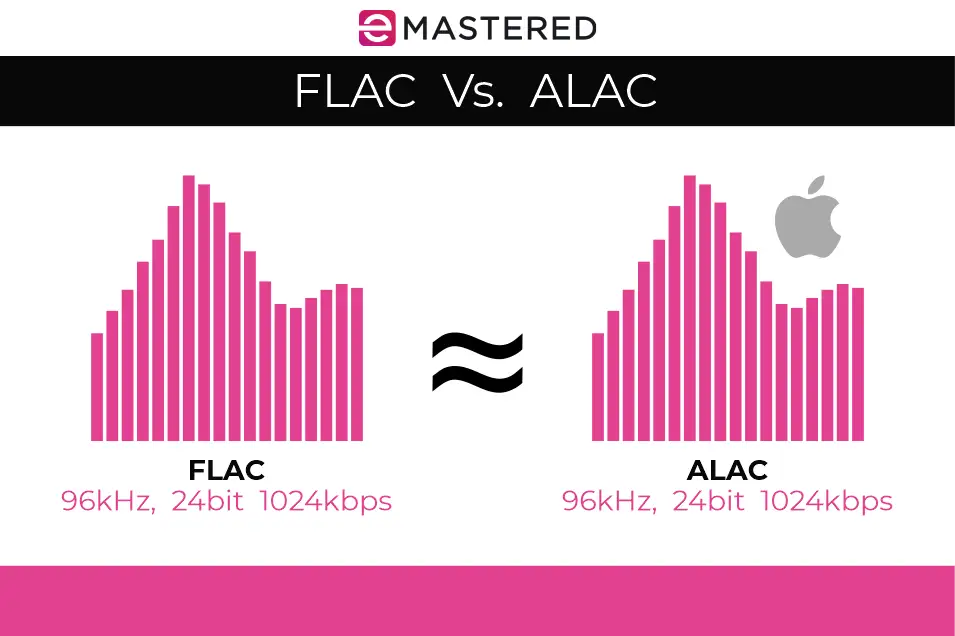
The Windows alternative is WMA, which stands for Windows Media Audio. This alternative was developed by Microsoft for Windows operating system. WMA can handle up to 24-bit/96kHz sampling rates, reproducing them without removing data.
Note that Windows also developed a WMA lossy format, which might be worth considering if you have a Windows computer and you want to cut down on your file sizes while enjoying higher audio fidelity than MP3.
AAC
AAC files are lossy compressed audio files that were created by a number of digital-tech companies, including Bell, Microsoft, and Dolby. The idea behind the creation of the AAC audio file format is that it was supposed to be more efficient than MP3.
If you've ever owned an iPod, then you've listened to the AAC audio file format before, as the iTunes store uses AAC files.
AAC is a bit more efficient than MP3, and many say that it sounds better. It is used for Apple Music's streaming platform, as well as YouTube's streaming platform.
WAV/AIFF
WAV (Waveform Audio File Format) files are one of the most common lossless, uncompressed audio formats around. People often use AIFF files in place of WAV files as well, as both of these file types have the same amount of information found on them. In essence, they perform very similarly.
Both of these files are based on PCM or pulse code modulation, which is one of the most straightforward methods of audio storage mechanism in the digital world.
The difference is that WAV files were developed for PC users by IBM and Microsoft, which is why you'll find them on Windows-based platforms. WAV is also the standard encoding format for CDs.
On the other hand, AIFF (Audio Interchange File Format) files were developed for Apple users as WAV alternatives. They aren't as widely used as WAV files, though they have far better support for metadata. Unlike a WAV file, you can include data like song titles and artwork on AIFF files.
AIFF files utilize pulse code modulation, meaning they don't compress or lose information along the way. If you record in Logic, you may notice that AIFF is one of the few choices you have.
Of course, you can use either format on each platform.
The main drawback of both of these kinds of files is that they are very large. A 16-bit/44.1kHz CD-quality file takes up about 10MB of space on average for each minute of audio.
With that said, they are the two files of choice for audio engineers who want audio that retains the highest quality sound.
OGG Vorbis
OGG Vorbis files often referred to as the Vorbis format, are lossy open-source files that were made as alternatives to AAC and MP3 files. The unique thing about this format is that it isn't restricted by any patent. Spotify's streaming service uses the OGG Vorbis format at 320kbps.
OGG doesn't actually stand for anything. In fact, OGG isn't actually a compression format. Rather, it's a unique multimedia container that is made to hold a wide range of compression formats. The reason why it's commonly called OGG Vorbis is that OGG typically holds Vorbis files.
Vorbis first came about in the year 2000. It became a popular audio format because it adhered to open-source software. Plus, compared to most lossy compression formats, it provides higher audio quality.
Other Less Common Audio Format Types
DSD
DSD is a high-resolution audio format that is used for Super Audio CDs. You'll find DSD in numerous varieties, including 2.8, 5.6, and 11.2MHz. It's a high-fidelity, uncompressed audio file that is great for quality listening, though not the most practical audio file format for streaming.
The unique thing about DSD files is that they only use a single bit, unlike uncompressed files that use a bit depth and sampling rate. These files sample that single bit 2.8 million times per second to recreate the file.
DSD files are very similar to high-resolution 24-bit/96kHz files. However, while this innovative format has incredible sound quality, it isn't very compatible with many operating systems. In fact, you have to use a third-party D/A converter to use a DSD file on a Mac or Windows system.
If you have a bit of extra cash to burn on an external D/A converter and you like the sound of sampling a single bit 2.8 million times per second, DSD might be worth considering.
MQA
MQA is another high-res lossless audio compression format that was made for more efficient streaming. Tidal uses MQA for high-resolution streaming, and many CDs use it as well.
How to Choose An Audio File Format
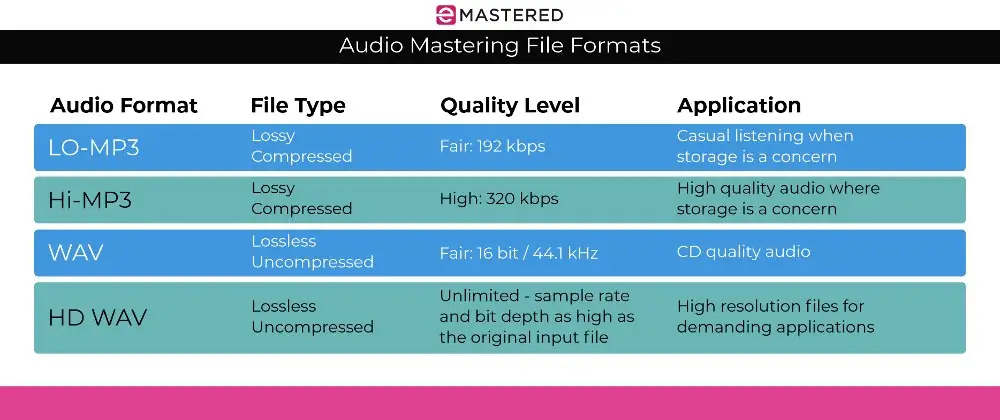
So, at this point, you have tons of audio file format information stored in your brain.
What do you do with it?
Choosing the right audio format for the application at hand can make a big difference.
The audio format that you choose to use will depend on whether you prefer sound quality or storage space. Beyond that, it will also depend on which devices you are using for playback.
If you're a general listener, you can enjoy compressed file formats with high bit rates, such as 320kbps AAC or MP3.
On the other hand, if you're a music producer or recording engineer, you'll want to use uncompressed audio files with high sample rates. One of the most popular is the 24bit/48kHz WAV and AIFF.
For serious, critical listening, however, many audiophiles recommend FLAC.
Wrapping Up Audio Formats
When all is said and done, there is no "best audio format."
Personal preference is the biggest factor that goes into finding the right audio format for you.
It's important to keep a few things in mind, including your storage space, your operating system, and how you want to perceive your music.
Of course, while having a bit of extra storage space is certainly nice, we never recommend sacrificing audio quality for it, especially if your focus is being the best audio engineer you can possibly be.
We hope that you can use this guide as a reference whenever you come across a file type that you are unsure of, as having knowledge of the various audio format types available will make you a more reliable producer or engineer in the long run.





